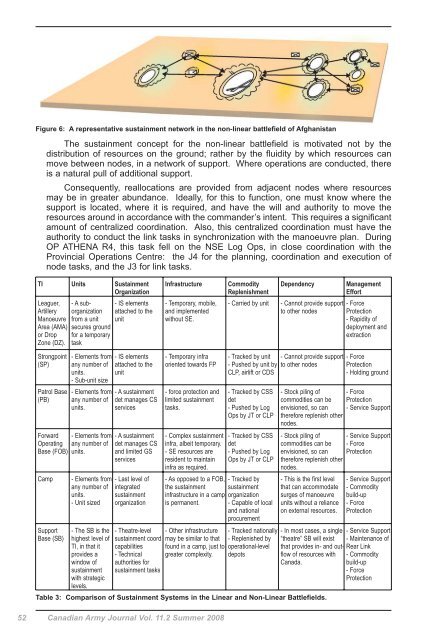Practical Sustainment Concepts for the Non-Linear Battlespace
Practical Sustainment Concepts for the Non-Linear Battlespace
Practical Sustainment Concepts for the Non-Linear Battlespace
You also want an ePaper? Increase the reach of your titles
YUMPU automatically turns print PDFs into web optimized ePapers that Google loves.
Figure 6: A representative sustainment network in <strong>the</strong> non-linear battlefield of Afghanistan<br />
The sustainment concept <strong>for</strong> <strong>the</strong> non-linear battlefield is motivated not by <strong>the</strong><br />
distribution of resources on <strong>the</strong> ground; ra<strong>the</strong>r by <strong>the</strong> fluidity by which resources can<br />
move between nodes, in a network of support. Where operations are conducted, <strong>the</strong>re<br />
is a natural pull of additional support.<br />
Consequently, reallocations are provided from adjacent nodes where resources<br />
may be in greater abundance. Ideally, <strong>for</strong> this to function, one must know where <strong>the</strong><br />
support is located, where it is required, and have <strong>the</strong> will and authority to move <strong>the</strong><br />
resources around in accordance with <strong>the</strong> commander’s intent. This requires a significant<br />
amount of centralized coordination. Also, this centralized coordination must have <strong>the</strong><br />
authority to conduct <strong>the</strong> link tasks in synchronization with <strong>the</strong> manoeuvre plan. During<br />
OP ATHENA R4, this task fell on <strong>the</strong> NSE Log Ops, in close coordination with <strong>the</strong><br />
Provincial Operations Centre: <strong>the</strong> J4 <strong>for</strong> <strong>the</strong> planning, coordination and execution of<br />
node tasks, and <strong>the</strong> J3 <strong>for</strong> link tasks.<br />
TI Units <strong>Sustainment</strong><br />
Organization<br />
Leaguer,<br />
Artillery<br />
Manoeuvre<br />
Area (AMA)<br />
or Drop<br />
Zone (DZ).<br />
Strongpoint<br />
(SP)<br />
Patrol Base<br />
(PB)<br />
Forward<br />
Operating<br />
Base (FOB)<br />
- A suborganization<br />
from a unit<br />
secures ground<br />
<strong>for</strong> a temporary<br />
task<br />
- Elements from<br />
any number of<br />
units.<br />
- Sub-unit size<br />
- Elements from<br />
any number of<br />
units.<br />
- Elements from<br />
any number of<br />
units.<br />
Camp - Elements from<br />
any number of<br />
units.<br />
- Unit sized<br />
Support<br />
Base (SB)<br />
- The SB is <strong>the</strong><br />
highest level of<br />
TI, in that it<br />
provides a<br />
window of<br />
sustainment<br />
with strategic<br />
levels.<br />
- IS elements<br />
attached to <strong>the</strong><br />
unit<br />
- IS elements<br />
attached to <strong>the</strong><br />
unit<br />
- A sustainment<br />
det manages CS<br />
services<br />
- A sustainment<br />
det manages CS<br />
and limited GS<br />
services<br />
- Last level of<br />
integrated<br />
sustainment<br />
organization<br />
- Theatre-level<br />
sustainment coord<br />
capabilities<br />
- Technical<br />
authorities <strong>for</strong><br />
sustainment tasks<br />
Infrastructure Commodity<br />
Replenishment<br />
- Temporary, mobile,<br />
and implemented<br />
without SE.<br />
- Temporary infra<br />
oriented towards FP<br />
- <strong>for</strong>ce protection and<br />
limited sustainment<br />
tasks.<br />
- Complex sustainment<br />
infra, albeit temporary.<br />
- SE resources are<br />
resident to maintain<br />
infra as required.<br />
Table 3: Comparison of <strong>Sustainment</strong> Systems in <strong>the</strong> <strong>Linear</strong> and <strong>Non</strong>-<strong>Linear</strong> Battlefields.<br />
52 Canadian Army Journal Vol. 11.2 Summer 2008<br />
Dependency Management<br />
Ef<strong>for</strong>t<br />
- Carried by unit - Cannot provide support<br />
to o<strong>the</strong>r nodes<br />
- Force<br />
Protection<br />
- Rapidity of<br />
deployment and<br />
extraction<br />
- Tracked by unit - Cannot provide support - Force<br />
- Pushed by unit by to o<strong>the</strong>r nodes Protection<br />
CLP, airlift or CDS<br />
- Holding ground<br />
- Tracked by CSS<br />
det<br />
- Pushed by Log<br />
Ops by JT or CLP<br />
- Tracked by CSS<br />
det<br />
- Pushed by Log<br />
Ops by JT or CLP<br />
- As opposed to a FOB, - Tracked by<br />
<strong>the</strong> sustainment sustainment<br />
infrastructure in a camp organization<br />
is permanent. - Capable of local<br />
and national<br />
procurement<br />
- O<strong>the</strong>r infrastructure<br />
may be similar to that<br />
found in a camp, just to<br />
greater complexity.<br />
- Tracked nationally<br />
- Replenished by<br />
operational-level<br />
depots<br />
- Stock piling of - Force<br />
commodities can be Protection<br />
envisioned, so can - Service Support<br />
<strong>the</strong>re<strong>for</strong>e replenish o<strong>the</strong>r<br />
nodes.<br />
- Stock piling of - Service Support<br />
commodities can be - Force<br />
envisioned, so can Protection<br />
<strong>the</strong>re<strong>for</strong>e replenish o<strong>the</strong>r<br />
nodes.<br />
- This is <strong>the</strong> first level<br />
that can accommodate<br />
surges of manoeuvre<br />
units without a reliance<br />
on external resources.<br />
- In most cases, a single<br />
“<strong>the</strong>atre” SB will exist<br />
that provides in- and outflow<br />
of resources with<br />
Canada.<br />
- Service Support<br />
- Commodity<br />
build-up<br />
- Force<br />
Protection<br />
- Service Support<br />
- Maintenance of<br />
Rear Link<br />
- Commodity<br />
build-up<br />
- Force<br />
Protection







![La modularite dans l'Armee de terre canadienne [pdf 1.6 MB]](https://img.yumpu.com/17197737/1/188x260/la-modularite-dans-larmee-de-terre-canadienne-pdf-16-mb.jpg?quality=85)









